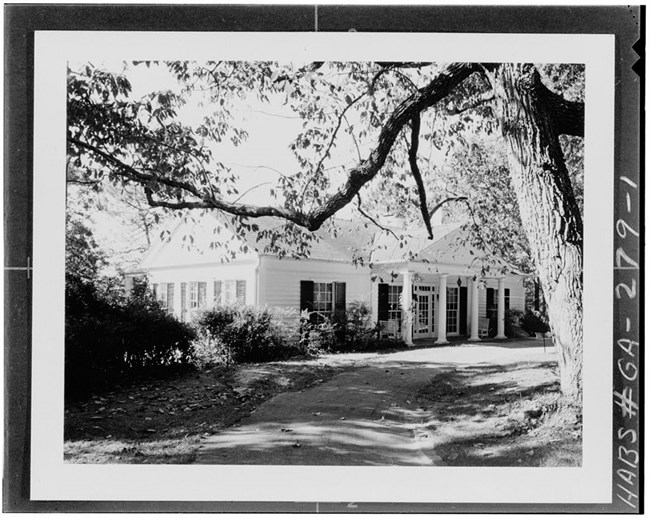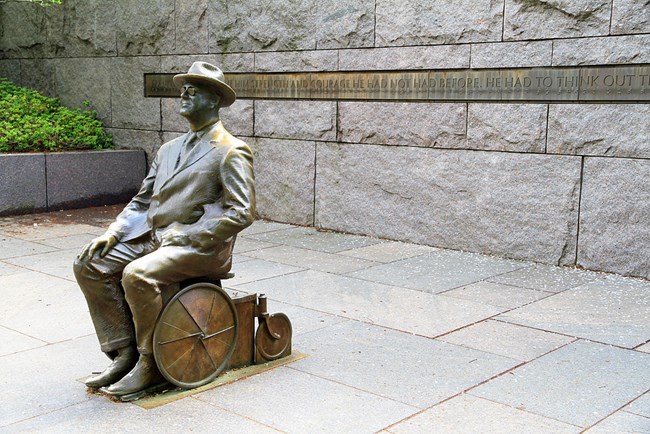Part of a series of articles titled Disability History.
Article
Disability History: Presidents and Disability
“We must promote-- to the best of our ability and by all possible and appropriate means-- the mental and physical health of all our citizens.” President John F. Kennedy, Special Message to the Congress, 1963[1]

Photo by the Historic American Buildings Survey in the collections of the Library of Congress (http://www.loc.gov/pictures/item/ga0421.photos.053893p/).
Nearly 50 million people live with disabilities in the US. This population has included our nation's presidents. Dwight Eisenhower had a learning disability. Abraham Lincoln lived with depression. James Madison had epilepsy. Franklin D. Roosevelt had polio. John F. Kennedy lived with several medical issues.[2] Places associated with these presidents, including those in NPS parks and recognized by NPS programs, continue to honor these presidents' memories. They also demonstrate changing ideas about disability.
Franklin D. Roosevelt was born in Hyde Park, New York in 1882. Hyde Park remained an important place for the Roosevelts throughout the president's life. He was buried there after his death in 1945. In 1921 at the age of 39, Roosevelt contracted poliomyelitis. Polio is an infectious disease that can cause paralysis. At this time, there was no vaccine for polio-- the vaccine was not available until 1955 when it was developed by Jonas Salk at the University of Pittsburgh School of Medicine. As a result, Roosevelt lost the use of his legs. With the help of his family, staff, and the press, Roosevelt often tried to hide his disability from the public. Many photographs depict Roosevelt draped in a blanket or cloak, which hid his wheelchair. As president, Roosevelt supported research in the treatment of polio. He founded the March of Dimes program, which was originally called the National Foundation for Infantile Paralysis. The March of Dimes today researches treatments and prevention of birth defects and infant mortality.

Roosevelt also frequented Warm Springs in Georgia. There he bathed in the therapeutic mineral springs. Mineral springs and wellness sanitariums were popular forms of treatment for wealthy individuals with physical disabilities in the early 1900s. Roosevelt later purchased the Warm Springs resort. It became a non-profit organization and was renamed the Warm Springs Institute for Rehabilitation.
Organized in 1955, the FDR Memorial Commission worked to promote the president's legacy. The memorial, located in Washington DC and opened in 1997, is physically accessible to all visitors. Ramps allow visitors to navigate with ease through the memorial. However, the original plan did not include a statue that featured FDR's disability. Disability activists lobbied for a sculpture which featured his wheelchair, and Congress agreed. In 2001, sculptor Robert Graham constructed the now famous statue of Roosevelt that depicts Roosevelt’s disability.

NPS / Matt Teuten
The John F. Kennedy National Historic Site also helps tell the complicated history of disability. The site is furnished to resemble how it looked in 1917 when John Kennedy was born. One year later, in 1918, the future president’s sister, Rosemary, was born. Due to complications at birth, Rosemary was born with intellectual and physical disabilities. She talked and moved differently than her fast-paced, competitive siblings. Still, Rosemary was a very social young woman. Her parents worked hard to involve her with their busy lifestyle. She joined them on trips to England and their summer home in Cape Cod. They also sent her to boarding schools on the East Coast and in Europe.
As a teenager and in her twenties, Rosemary exhibited manic, aggressive behavior. Her family decided that doctors should perform a lobotomy on her at age 23. A lobotomy is a surgery that severs brain tissue. In the 1940s and '50s, doctors believed a lobotomy could relieve "mental disorders." However, lobotomies also had grave side effects. Rosemary's lobotomy was a failure. She lost her ability to use the bathroom properly, and her speech was affected. Rosemary spent much of the rest of her life in an institution.
John F. Kennedy, meanwhile, established several legal measures to support research and treatment for people with disabilities. Kennedy’s sister and founder of the Special Olympics, Eunice, pushed the president to address disability in public. Since then, many presidents and members of Congress have furthered these goals.
Article by Perri Meldon.
This article is part of the Telling All Americans’ Stories Disability History Series. The series focuses on telling selected stories through historic places. It offers a glimpse into the rich and varied history of Americans with disabilities.
Bibliography:
[1] John F. Kennedy. "Special Message to the Congress on Mental Illness and Mental Retardation," February 5, 1963. The American Presidency Project.
[2] Ask EARN Staff. "Disability in History: U.S. Presidents." Employer Assistance and Resource Network on Disability Inclusion, March 7, 2014.
Last updated: July 28, 2020
